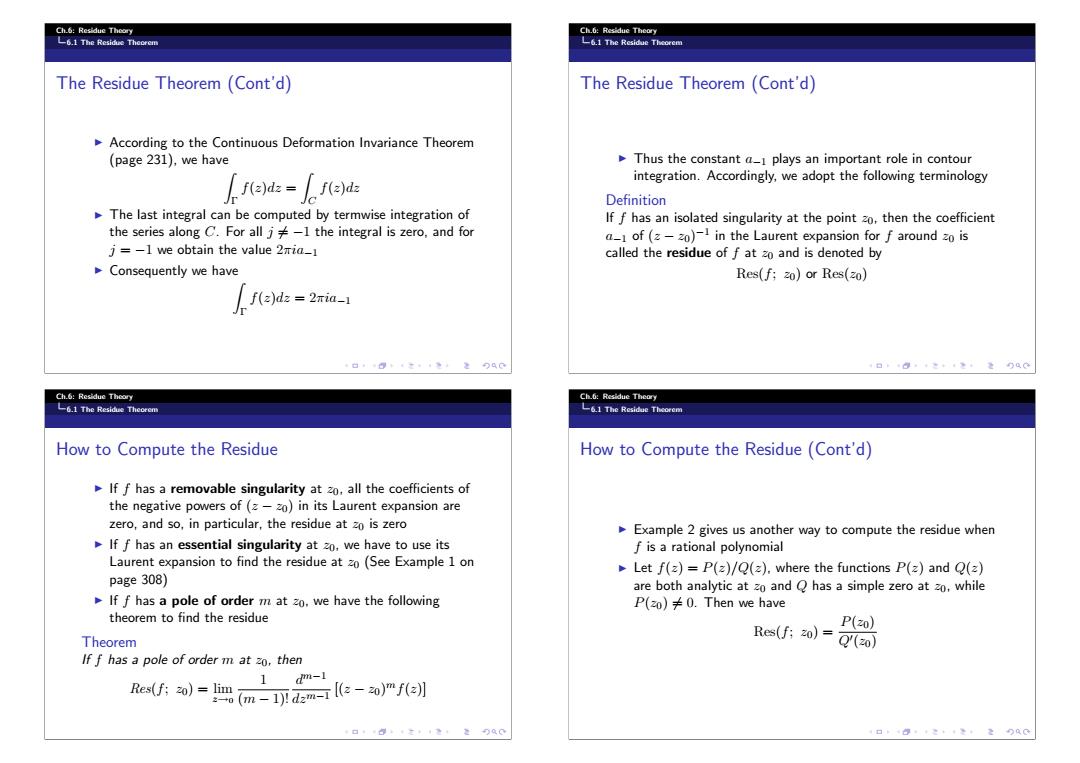正在加载图片...

Ch.6:Residue Thoory Ch.6:Residue Theory L6.1 The Residue Theorem L6.1 The Residue Theorem The Residue Theorem(Cont'd) The Residue Theorem(Cont'd) According to the Continuous Deformation Invariance Theorem (page 231),we have Thus the constant a-1 plays an important role in contour integration.Accordingly,we adopt the following terminology f(z)dz=f(z)dz Definition The last integral can be computed by termwise integration of If f has an isolated singularity at the point zo,then the coefficient the series along C.For allj-1 the integral is zero,and for a-1 of (z-z0)-1 in the Laurent expansion for f around zo is j=-1 we obtain the value 2mia-1 called the residue of f at zo and is denoted by Consequently we have Res(f:z0)or Res(zo) f(z)dz =2wia-1 Ch.6:Residue Theory Ch.6:Residue Theory 6.1 The Residue Theorem L6.1 The Residue Theorem How to Compute the Residue How to Compute the Residue(Cont'd) If f has a removable singularity at z0.all the coefficients of the negative powers of(z-z0)in its Laurent expansion are zero,and so,in particular,the residue at zo is zero Example 2 gives us another way to compute the residue when If f has an essential singularity at zo.we have to use its f is a rational polynomial Laurent expansion to find the residue at zo(See Example 1 on Let f(z)=P(z)/Q(z).where the functions P(z)and Q(z) page 308) are both analytic at zo and Q has a simple zero at zo,while If f has a pole of order m at zo.we have the following P(zo)≠0.Then we have theorem to find the residue P(2z0) Theorem Rs(f:20)=Q(2o If f has a pole of order m at zo.then 1 dm-1 (m-1)!dm(0)mf()] Res(f:2o)=lim万Ch.6: Residue Theory 6.1 The Residue Theorem The Residue Theorem (Cont’d) According to the Continuous Deformation Invariance Theorem (page 231), we have Γ f(z)dz = C f(z)dz The last integral can be computed by termwise integration of the series along C. For all j = −1 the integral is zero, and for j = −1 we obtain the value 2πia−1 Consequently we have Γ f(z)dz = 2πia−1 Ch.6: Residue Theory 6.1 The Residue Theorem The Residue Theorem (Cont’d) Thus the constant a−1 plays an important role in contour integration. Accordingly, we adopt the following terminology Definition If f has an isolated singularity at the point z0, then the coefficient a−1 of (z − z0)−1 in the Laurent expansion for f around z0 is called the residue of f at z0 and is denoted by Res(f; z0) or Res(z0) Ch.6: Residue Theory 6.1 The Residue Theorem How to Compute the Residue If f has a removable singularity at z0, all the coefficients of the negative powers of (z − z0) in its Laurent expansion are zero, and so, in particular, the residue at z0 is zero If f has an essential singularity at z0, we have to use its Laurent expansion to find the residue at z0 (See Example 1 on page 308) If f has a pole of order m at z0, we have the following theorem to find the residue Theorem If f has a pole of order m at z0, then Res(f; z0) = lim z→0 1 (m − 1)! dm−1 dzm−1 [(z − z0)mf(z)] Ch.6: Residue Theory 6.1 The Residue Theorem How to Compute the Residue (Cont’d) Example 2 gives us another way to compute the residue when f is a rational polynomial Let f(z) = P(z)/Q(z), where the functions P(z) and Q(z) are both analytic at z0 and Q has a simple zero at z0, while P(z0) = 0. Then we have Res(f; z0) = P(z0) Q(z0)��������������